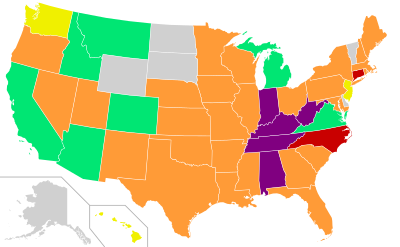
Independent commission
Politician commission
Passed by legislature with gubernatorial approval
Passed by legislature, governor plays no role
Passed by legislature, simple majority veto override
Not applicable due to having one at-large district
- The Ohio Constitution requires that redistricting votes in the Ohio Legislature be bipartisan, with a minimum number of votes required from both parties for a redistricting act to pass
- Legislative reversal of the redistricting commission created by 2018 Utah Proposition 4 is the subject of a constitutionality lawsuit.[1]

State legislatures control redistricting
Commissions control redistricting
Nonpartisan staff develop the maps, which are then voted on by the state legislature
No redistricting due to having only one congressional district
In the United States, a redistricting commission is a body, other than the usual state legislative bodies, established to draw electoral district boundaries. Generally the intent is to avoid gerrymandering, or at least the appearance of gerrymandering, by specifying a nonpartisan or bipartisan body to comprise the commission drawing district boundaries.
- ^ Michael Wines (July 11, 2024). "Utah's Gerrymandered House Map Ignored Voters' Will, State Supreme Court Says". The New York Times.
